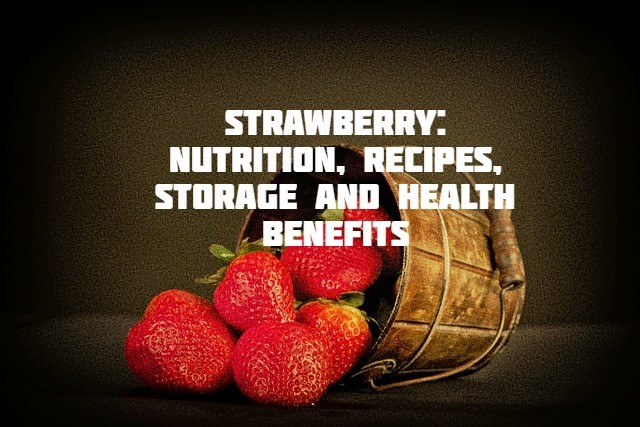
Contents
At the arrival of spring, the strawberry makes its presence on our stalls for the happiness of the most greedy. This small red fruit is rich in vitamins and minerals and has many health benefits. It is usually eaten as a dessert, raw with sugar or whipped cream, but it also goes very well with salads for a sweet/salty mix.
Read Also: 50 Foods That Are Super Healthy
Characteristics of the strawberry:
- Low calorie
- Rich in fiber
- Rich in vitamin C
- Source of antioxidants
- Stimulates the immune system
The strawberry, what is it?
Identity card of the strawberry
- Type: Bay
- Family: Rosaceae
- Origin: America, Asia, and Europe
- Season: April to June
- Color: Bright red
- Flavor: Sweet
Characteristics of the strawberry
At harvest, the strawberry is a small bright red fruit with small grains and a green peduncle. Its texture is moderately firm.
Read Also: Six Essential Nutrients Which Are Important For Your Body
Word of the nutritionist
Strawberries are full of water and low in calories. They are a food of choice in times of weight loss. One serving corresponds to 150 to 200g of strawberries.
Nutritional values
For 100g of raw strawberries:
|
nutrients |
Quantities |
|
protein |
0.7 g |
|
lipids |
0.4 g |
|
carbohydrates |
7 g |
|
Water |
89.9 g |
|
fibers |
2 g |
|
60 mg |
|
|
Vitamin B9 |
62 μg |
|
Calcium |
20 mg |
|
Potassium |
152mg |
|
12 mg |
|
|
Manganese |
0.3 mg |
Read Also: what are the health benefits of papaya
7 proven health benefits of strawberry
- 1. Strawberries are rich in water which contributes to the coverage of daily water needs.
- 2. The strawberry contains flavonoids that give it its red color and are among the mishmash that provide the most to its antioxidant capacity. Among the flavonoids, there are anthocyanins, which have a defensive effect against cancer. They would also inhibit the growth of human cancer cells in the colon, prostate and oral cavity.
- 3. Strawberries are sources of fiber that will stimulate intestinal transit and limit bloating.
- 4. Strawberry is a source of manganese that acts as a cofactor for several enzymes that facilitate a dozen different metabolic processes.
- 5. This red delicious fruit also participates in the prevention of damage caused by free radicals.
- 6. The strawberry is rich in vitamin C which helps fight against fatigue, stimulate the immune system and fight against various infections and winter cold snaps.
- 7. Strawberry is a source of vitamin B9 that allows the healthy development of the fetus during pregnancy.
Choose your strawberry
The best strawberries are the ones you pick from your garden or at the producers. It is always best to pick in the cool early morning, while the fruits are still firm and bursting with flavor.
If they are not harvested, they will be bought directly from the grower, who harvests them the same morning, which is not usually the case with strawberries offered in grocery stores.
The fruits must be of good behavior and a beautiful bright red, the peduncle green and fresh appearance.
Read Also: 5 Proven Health Benefits Of Dates
The different varieties
What differentiates the different strawberry varieties is their size, shape, and flavor. There are sweet and sour strawberries such as Gariguette or Ciflorette, sweet strawberries such as Cléry and Darselect, and wood-flavored strawberries such as Mara des Bois and Charlotte.
Storage
Fridge. Two or three days. Avoid piling them up and washing them until serving them. They should be washed quickly, keeping their peduncles to prevent them from imbibing water. They are drained, stripped and served as soon as possible. Also, avoid airtight packaging, fruits should breathe.
Freezer. Wash the fruit in ice-cold water, shake it, drain it and place it on a plate, spacing them. Quickly freeze in the coldest part of the freezer. Then enclose them in a bag to freeze, ideally in a single layer. They can also be rolled in sugar before being frozen in the same way.
Read Also: Benefits Of Eating Watermelon For Health, Skin and Hair
Preparation of the strawberry
How to cook it? How to match it?
- They can be served as an appetizer with cheeses and nuts.
- Sliced on vanilla ice cream with semi-sweet chocolate chips.
- In coulis, ice cream, sorbets, granita, compotes, and jams.
- Milkshake: vanilla ice cream, milk and strawberries blended. Or soy milk, yogurt, and strawberries.
- Mint accompanies them perfectly.
- In fruit salads, but also vegetables. For example, with Boston lettuce and sliced red onion. Serve with a strawberry vinegar vinaigrette (prepared by marinating a few days, in white wine vinegar, chopped strawberries, and a little sugar, then filtering the mixture).
- Put them in the pan or on the grill and serve them lukewarm.
- Dip them halfway into chocolate that you have melted with a little brandy. Let cool on wax paper, then ten minutes in the refrigerator. Serve the same day.
- Grill them on skewers with other pieces of fruit after coating them with a sauce made from lemon juice and orange, honey and cornstarch.
- Prepare a barbecue sauce with fresh strawberries, ketchup, soy sauce, lemon juice and zest, green onions and coriander leaves. Blend and serve with fish, poultry or grilled meat.
- Serve antipasto with other chopped fruit, parmesan cheese, and finely sliced prosciutto. Sprinkle with a vinaigrette made of olive oil, vinegar, mustard, and garlic.
- In an oven set at 150 ° C (300 ° F), cook a piece of brie until the interior melts. Remove the top of the cheese, line with strawberries and pieces of flaked almonds and sprinkle with sugar.
- Let marinate for a few hours in a little balsamic vinegar and sugar. Serve to the season with freshly ground pepper. Astonishing, but delicious.
- In cakes, pancakes, waffles, muffins, and custards. Strawberry shortcake is a classic of North American cuisine. It is prepared with a cake of Savoy (cake of angels) cut in half horizontally and topped with whipped cream and strawberries.
- Rhubarb and strawberry marry wonderfully in a pie.
Read Also: The Amazing Benefits Of Mulberry
Cons-indications
It has long been thought that people with diverticulosis should not consume certain fruits (raspberries, blackberries, strawberries …) for fear that their small seeds are lodged in the diverticula. However, no clinical study has been performed to validate this hypothesis. According to a panel of experts from the American College of Gastroenterology, it would not be necessary to exclude these foods in case of diverticulosis. In some individuals, however, small fruit seeds can irritate the intestine. It may be advisable for these people to consult a dietician-nutritionist.
History of the strawberry
The term “strawberry” appeared in the French language in the twelfth century. It derives from the popular Latin fragra, which gave the ancient French spawning. Fragra refers to the fragrance of this berry that, it seems, fine noses can spot at great distances.
Read Also: 9 Incredible Health Benefits Of Guava Fruit
For further
organic gardening
Except for wild strawberry, which can be reproduced by seeds, the plant is multiplied by root division or rooting of stolons (creeping stems that produce roots instead of stolons). Buy certified seedlings free of viruses. Keep the plants in the refrigerator until they are planted.
Plant in rather sandy soil, but rich in compost, well-drained and sunny, if possible slightly sloping. Avoid the lower parts of the garden, or “jelly holes,” where cold drafts come together. Choose a location that, in the past 2 years, has not received tomatoes, peppers, potatoes or eggplants to avoid the risk of diseases that the strawberry shares with these plants.
Plant in single rows or beds, spacing plants from 45 cm to 60 cm for stolon varieties, and 30 cm for alpine varieties.
Ecology and environment
According to the US Environmental Working Group, strawberries grown would be among the 12 products most contaminated by chemical residues17. The agency based its findings on data from the US Food and Drug Administration (FDA) on pesticide residue levels.
Note that all products had been washed before analysis, to reflect the reality that consumers usually wash their fruits and vegetables before consuming them. In short, washing does not eliminate, far from it, all pesticide residues. Hence the recommendation of the Environmental Working Group to focus as much as possible on organic strawberries.
Read Also: 9 Health Benefits Of Avocado for women
Read Also: 10 Foods That Make You Happy




